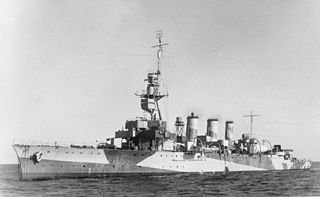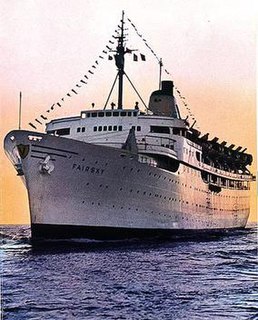
HMAS Adelaide was a Town-class light cruiser of the Royal Australian Navy (RAN), named after Adelaide, the capital city of South Australia. Laid down in 1915, wartime shortages and design modifications meant the ship was not completed until 1922, earning her the nickname "HMAS Longdelayed".

The Ton class were coastal minesweepers built in the 1950s for the Royal Navy, but also used by other navies such as the South African Navy and the Royal Australian Navy. They were intended to meet the threat of seabed mines laid in shallow coastal waters, rivers, ports and harbours, a task for which the existing ocean-going minesweepers of the Algerine-class were not suited.

Brigham is a village in the Allerdale borough of Cumbria, England. The village is near to the town of Cockermouth and is located just outside the Lake District National Park.

The Turbine Steamship Fairsky was a one-class Italian-styled passenger ship operated by the Sitmar Line, best known for service on the migrant passenger route from Britain to Australia from May 1958 until February 1972. After a 20-month lay-up at Southampton, Fairsky completed two further voyages to Australia, before returning to be based at Sydney as a popular full-time cruise ship, until striking an unmarked wreck in 1977 which rendered the vessel uneconomic to permanently repair. The ship was finally sold to a Philippines based consortium, intended for static use as a casino and floating hotel. In 1979 during refurbishment at Manila Bay for her new role, a fire broke out onboard which destroyed the accommodation. The wreck was towed to Hong Kong for demolition in 1980.
HMS Arlingham was one of 93 ships of the Ham class of inshore minesweepers.
HMS Kingham was a Ham-class minesweeper of the Royal Navy.
HMS Mersham was a Ham-class minesweeper of the Royal Navy. All ships of the class were named after villages ending in -ham. The minesweeper was named after Mersham in Kent. Constructed at Appledore, in Devon, Mersham was launched in April 1954 and completed in January 1955. In April 1955, the ship was transferred to the French Navy and in French service, was known by its pennant number, M773, until it was renamed Violette in 1964. Throughout the 1950s and early 1960s, the vessel undertook minesweeping duties from Brest in Brittany, before being laid up in 1965. In 1974, the ship was transferred to the Gendarmerie and undertook patrol duties until finally being decommissioned in 1987.
HMS Petersham was a Ham-class minesweeper of the Royal Navy.
HMS Powderham was one of 93 ships of the Ham class of inshore minesweepers named after villages ending in -ham, in this case Powderham in Devon. She was launched on 27 November 1958 by J. Samuel White & Company Ltd, Cowes and commissioned in 1959. She was allocated pennant number M 2720.
HMS Saxlingham was one of 93 ships of the Ham-class of inshore minesweepers.

Tradewind is a Dutch topsail schooner. She was built in the Netherlands in 1911 as a herring lugger named Sophie Theresia.

Sitmar Cruises and its predecessor Sitmar Line were company names derived from the acronym for the Societa Italiana Trasporti Marittimi. SITMAR originally was an Italian shipping line founded by Russian émigré Alexandre Vlasov, however the company's headquarters were later transferred to Monaco. Vlasov initially operated cargo services from 1937, gradually replacing these with passenger services from 1947 until 1988, when SITMAR was sold to the Peninsular and Oriental Steam Navigation Company (P&O). After the sale, most of the former SITMAR ships were transferred to the fleet of P&O subsidiary Princess Cruises, while one, TSS Fairstar, became the sole vessel of the newly created P&O-Sitmar Cruises. As of July 2018, one briefly named former SITMAR ship was still operational, as Cruise & Maritime Voyages's Columbus. However, two other vessels originally ordered by SITMAR but delivered to P&O, sailed under the Princess banner before operating from Australia for a number of years, as Pacific Jewel and Pacific Dawn. As of 2021, Pacific Dawn, set to become Ambience is the only survivor, with Columbus and Pacific Jewel being sold for scrap.
HMSAS Parktown was a minesweeping whaler of the South African Naval Services that was sunk during the Second World War. She was built as the whaler Southern Sky for the Southern Whaling and Sealing Company in 1929 and sold in 1936 to the Union Whaling Company, acquiring the new name Sidney Smith. She was requisitioned on 8 August 1940 as HMSAS Parktown and was converted to sweep magnetic mines. She arrived at Tobruk on 10 June 1942 just in time to take part in the evacuation of Allied forces. She was the last ship to leave Tobruk harbour prior to its capitulation to German forces on 20 June 1942. Parktown embarked 60 troops and took a tug in tow outside the harbour. Her reduced speed led to her being attacked by German E-boats, most probably German E-boats from Derna. Gunfire from the motor boats destroyed the bridge, ruptured the boiler, killed or wounded half of the men on board and led to on-board ammunition exploding, causing her to finally stop moving and setting the ship on fire. She was finally sunk on the evening of 21 June 1942 by an Allied MTB which had arrived to pick up survivors.

Torrens was a clipper designed to carry passengers and cargo between London and Port Adelaide, South Australia. She was the fastest ship to sail on that route, and the last sailing ship on which Joseph Conrad would serve before embarking on his writing career.
HMCS Grandmère was a Bangor-class minesweeper constructed for the Royal Canadian Navy during the Second World War. Entering service in 1941, the minesweeper took part in the Battle of the Atlantic and the Battle of the St. Lawrence before being taken out of service in 1945. The ship was sold for mercantile service following the war, first as the yacht Elda and then the cargo ship Jacks Bay. The ship was sold for scrap in 1968.
HMCS Quinte was a Bangor-class minesweeper constructed for the Royal Canadian Navy during the Second World War. The ship entered service in 1941 and took part in the Battle of the Atlantic. On 30 November 1942, Quinte ran aground and sank off Cape Breton Island. The ship was re-floated and repaired and spent the rest of the war as a training ship. Following the war, the minesweeper was used for naval research until decommissioned in 1946. The vessel was sold for scrap and broken up in 1947.
HMCS Fort William was a Bangor-class minesweeper that served with the Royal Canadian Navy during the Second World War. Entering service in 1942, the minesweeper participated in the Battle of the Atlantic as a convoy escort and in the invasion of Normandy. Following the war, the ship was laid up, but was reacquired during the Korean War. Fort William never re-entered service with the Royal Canadian Navy and in 1957, was sold to Turkey. Renamed Bodrum by the Turkish Navy, the ship was discarded in 1971.
HMCS Trois Rivières, alternatively spelled Trois-Rivieres and Trois-Rivières, was a Bangor-class minesweeper that served with the Royal Canadian Navy during the Second World War. The ship entered service in 1942 and served as a patrol and convoy escort vessel in the Battle of the Atlantic. Following the war, the minesweeper was transferred to the Royal Canadian Mounted Police and renamed MacBrien. The vessel was sold for scrap and broken up in 1960.

HMSAS Protea was the first hydrographic survey ship used by the South African Naval Service. The ship was laid down as a minesweeper to be named HMS Ventnor in 1917 but was renamed HMS Verwood in 1918 before she was launched. She was again re-named and launched as HMS Crozier on 1 July 1919. The vessel was converted from a minesweeper to a hydropraphic survey vessel in 1921 and transferred to the South African forces in 1922, where she was commissioned as HMSAS Protea. She served as a survey vessel until 1933 when she was returned to the Royal Navy. Protea was eventually sold by the Royal Navy and renamed MV Queen of the Bay where she went on to operate as a pleasure craft out of Blackpool. She was subsequntly sold to the Spanish Navy and renamed Lieutenant Captain Remigio Verdia, and used as supply vessel to run blockades, smuggling supplies to the anti-fascists in Spain during the civil war. She ran aground and sunk off Cartagena in Spain in 1939.







